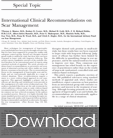Following are some excerpts from clinical papers regarding silicone gel sheeting:
 Mustoe, T. et al. (2002). International Recommendations on Scar Management. (August 2002) 110(2)Plastic and Reconstructive Surgery p560-571.
Mustoe, T. et al. (2002). International Recommendations on Scar Management. (August 2002) 110(2)Plastic and Reconstructive Surgery p560-571.
"Silicone gel sheeting has been a widely used clinical management option for hypertrophic scars and keloids since the early 1980's. despite initial skepticism, there is now good evidence of its efficacy and silicone gel sheeting has now become standard care for plastic surgeons".
"These recommendations support a move to a more evidence-based approach in scar management. This approach highlights a primary role for silicone gel sheeting and intralesional corticosteroids in the management of a wide variety of abnormal scars".
Gold, M.H., (1993). Topical Silicone Gel Sheeting in the Treatment of Hypertrophic Scars and Keloids. A dermatologic experience. (1993) J Dermatol Surg Oncol. Oct;19(10):896
CONCLUSION. Topical silicone gel sheeting is an effective method for the treatment of hypertrophic and keloid scars and may be considered useful in the treatment of these difficult cutaneous lesions.
Ahn ST, Monafo W, Mustoe TA (1989) Topical Silicone Gel: A New Treatment for Hypertrophic Scars. (1989) Surgery Oct, 106 4:781-786
“the treated scars were improved significantly at 4, 8, and 12 weeks, compared with both their own treatment value and the control scars”... “We conclude that this simple method of treating hypertrophic scar is efficacious, even in relatively chronic cases.”
Eishi K, Bae SJ, Ogawa F, Hamasaki Y, Shimizu K, and Katayama I . (2003) Silicone gel sheets relieve pain and pruritus with clinical improvement of keloid: possible target of mast cells. (2003) The Journal of dermatological treatment; 14(4):248-52.
"Silicone gel sheeting is effective and safe, especially with more severe symptoms of pain and itching possibly induced by mediators derived from increased mast cells.”
Dockery GL, Nilson RZ. (1994). Treatment of hypertrophic and keloid scars with SILASTIC Gel Sheeting. (1994) Mar-Apr;33(2). J Foot Ankle Surg.:110-9.
Department of Podiatric Surgery, Waldo Podiatric Residency Program, Fifth Avenue Hospital, Seattle, Washington.
"Overall, the success rate (somewhat improved to greatly improved) for the treatment of hypertrophic and keloid scars is high (95%)".
Tonseth KA, Tindholdt TT, Solberg US, Busic V, Mesic H, Begic A. (2003). Keloid and Hypertrophic Scars.Tidsskr Nor Laegeforen. 2003 Nov 6;123(21):3033-5
“Patients who are at high-risk or show excessive scar development should follow standard treatment. First-line therapy is silicone sheeting…”
Gold, M.H., Foster, T.D., Adair, M.A., Burlison, K., Lewis, T., (2001) Prevention of Hypertrophic Scars and Keloids by the Prophylactic Use of Topical Silicone Gel Sheets Following a Surgical Procedure in an Office Setting. Dermatol Surg 2001; 27:641-644.
CONCLUSION: Topical silicone gel sheeting, with a 20 year history of satisfaction in dermatology, now appears to be useful in the prevention of hypertrophic scars and keloids in patients undergoing scar revision.

